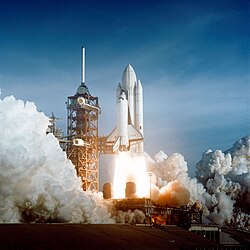STS-41-C
| Missionsemblem | |||
|---|---|---|---|
 | |||
| Missionsdaten | |||
| Mission | STS-41-C | ||
| NSSDCA ID | 1984-034A | ||
| Besatzung | 5 | ||
| Start | 6. April 1984, 13:58:00 UTC | ||
| Startplatz | Kennedy Space Center, LC-39A | ||
| Anzahl EVA | 2 | ||
| Landung | 13. April 1984, 13:38:07 UTC | ||
| Landeplatz | Edwards Air Force Base, Bahn 17 | ||
| Flugdauer | 6d 23h 40min 7s | ||
| Erdumkreisungen | 108 | ||
| Bahnhöhe | 468 km | ||
| Bahnneigung | 28,5° | ||
| Zurückgelegte Strecke | 4,6 Mio. km | ||
| Nutzlast | LDEF | ||
| Mannschaftsfoto | |||
 v. l. n. r. Robert Crippen, Terry Hart, James van Hoften, George Nelson, Francis Scobee | |||
| ◄ Vorher / nachher ► | |||
| |||
STS-41-C (englisch Space Transportation System) ist eine Missionsbezeichnung für das US-amerikanische Space Shuttle Challenger (OV-99) der NASA. Der Start erfolgte am 6. April 1984. Es war die elfte Space-Shuttle-Mission und der fünfte Flug der Raumfähre Challenger.
Mannschaft
- Robert Crippen (3. Raumflug), Kommandant
- Francis Scobee (1. Raumflug), Pilot
- Terry Hart (1. Raumflug), Missionsspezialist
- James van Hoften (1. Raumflug), Missionsspezialist
- George Nelson (1. Raumflug), Missionsspezialist
Missionsüberblick


Einer der Höhepunkte der Shuttle-Mission war die Reparatur des Satelliten Solar Maximum Mission (SMM) direkt im Orbit. Mit den beim vorherigen Flug erfolgreich getesteten Manned Maneuvering Units konnten die Astronauten James van Hoften und George Nelson zum Satelliten fliegen und dort unter anderem das Lageregelungssystem austauschen. Probleme beim Einfangen des Satelliten führten dabei zu einer zusätzlichen Erdumkreisung und der Landung auf der Edwards Air Force Base anstelle des Kennedy Space Centers. Auch wurde die Long Duration Exposure Facility (LDEF) mit insgesamt 57 Experimenten an Bord ausgesetzt, damit eine spätere Shuttle-Mission diese wieder einsammelt. Der cineastische Höhepunkt der Mission war die IMAX-Kamera, die sich während der Mission an Bord befand.
Diese Mission war ursprünglich unter der Bezeichnung STS-13 geplant worden. Durch das neue Nummerierungssystem für Shuttleflüge wurde daraus jedoch STS-41-C. Aufgrund von Änderungen in der Startreihenfolge handelte es sich tatsächlich um die elfte, nicht die dreizehnte Shuttle-Mission.
Siehe auch
Weblinks
- NASA-Missionsüberblick (englisch)
- Videozusammenfassung mit Kommentaren der Besatzung (englisch)
Auf dieser Seite verwendete Medien
The April 12 launch at Pad 39A of STS-1, just seconds past 7 a.m., carries astronauts John Young and Robert Crippen into an Earth orbital mission scheduled to last for 54 hours, ending with unpowered landing at Edwards Air Force Base in California.
LDEF: After Deployment
The crew assigned to the STS-41CB (STS-13) mission included (left to right) Robert L. Crippen, commander; Terry J. Hart, mission specialist; James D. Van-Hoften, mission specialist; George D. Nelson, mission specialist; and Francis R. (Dick) Scobee, pilot. Launched aboard the Space Shuttle Challenger on April 6, 1984 at 8:58:00 am (EST), the STS-41C mission marked the first direct ascent trajectory for the Space Shuttle. The crew deployed the Long Duration Exposure Facility (LDEF).
The patch features a helmet visor of an astronaut performing an extravehicular activity. In the visor are reflected the sun's rays, the Challenger and its remote manipulator system (RMS) deploying the long duration exposure facility (LDEF), the Earth and blue sky, and another astronaut working at the damaged Solar Maximum Satellite (SMS). The scene is encircled by the surnames of the crewmembers.
Launched April 6, 1984, one of the goals of the STS-41C mission was to repair the damaged free-flying Solar Maximum Mission Satellite (SMMS), or Solar Max. The original plan was to make an excursion out to the SMMS and capture it for necessary repairs. Pictured is Mission Specialist George Nelson approaching the damaged satellite in a capture attempt. This attempted feat was unsuccessful. It was necessary to capture the satellite via the orbiter's Remote Manipulator System (RMS) and secure it into the cargo bay in order to perform the repairs, which included replacing the altitude control system and the coronograph/polarimeter electronics box. The SMMS was originally launched into space via the Delta Rocket in February 1980, with the purpose to provide a means of studying solar flares during the most active part of the current sunspot cycle. Dr. Einar Tandberg-Hanssen of Marshall Space Flight Center's Space Sciences Lab was principal investigator for the Ultraviolet Spectrometer and Polarimeter, one of the seven experiments of the Solar Max.





